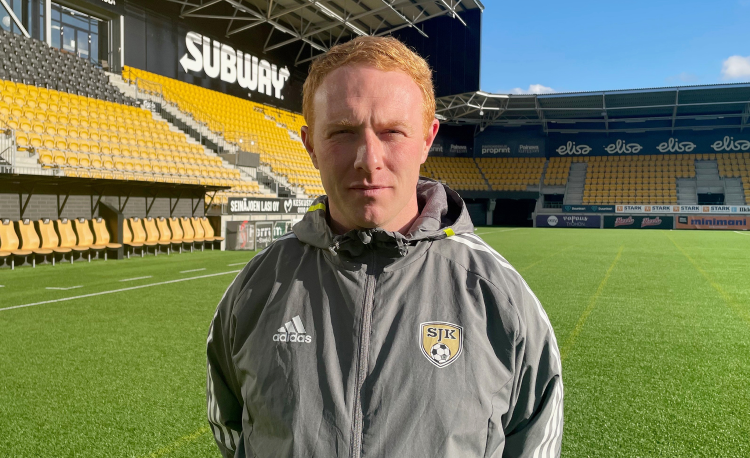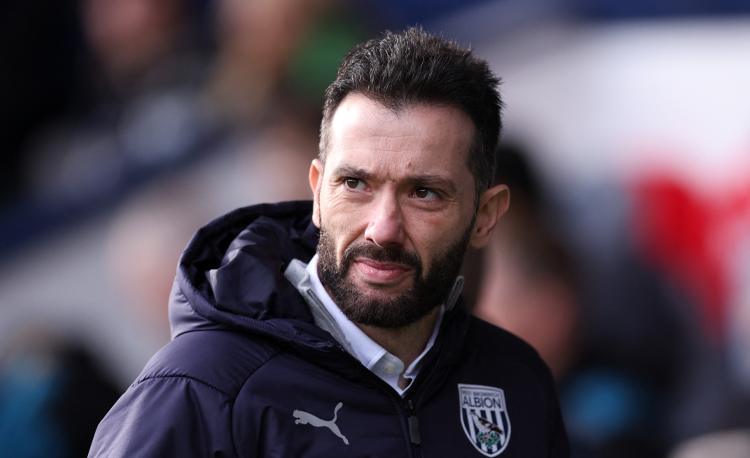You are viewing 1 of your 1 free articles
Passing and running in behind
With this training session we are looking to improve the habits of our players in terms of encouraging them to make that killer pass, with good mobility ahead of the ball helping players to make a well-executed pass in behind.
| Area | Up to full pitch |
| Equipment | Balls, bibs, cones, 4 mini goals, 2 full size goals, 8 mannequins |
| No. of Players | Up to 20 outfield players + 2 goalkeepers |
| Session Time |
Vertical possession: 8mins |
With this training session we are looking to improve the habits of our players in terms of encouraging them to make that killer pass, with good mobility ahead of the ball helping players to make a well-executed pass in behind. In fact, part of this session will involve the decision making process when players link and combine under pressure to set the forward pass.
Players enjoy this session because it gives them freedom within a framework. More than that, it delivers what they like as players and what I, as a coach, am looking for in possession.
When they are on the ball, we want players to feel they’re able to try the most ambitious passes and to develop technique, vision and creativity. When off the ball, we want players to try to get into goal scoring positions, creating a dynamic and enjoyable training session for everyone.
We came up with this session because we were becoming more focused on lots of passes and building play in a really controlled way, and we wanted to encourage players to be more ambitious both on and off the ball, looking to stretch the game and to look for passes behind a defensive line.
We would tend to run one of these activities in a week when we expect to face an opponent playing a high line or against opposition with a slow defence.
“The players enjoy this session because it gives them freedom within a framework”
VERTICAL POSSESSION
After a 12-minute warm-up [not shown], we set up a narrow rectangular playing area of 15x45 yards. We set this up to be narrow so players would have to look for “up-back-through” type of actions, and use third man runs and different rotations, to lose their markers.
We’re using 13 outfield players split into two teams of five and three yellow floaters who play for the team in possession. The reds and the blues go up against each other in a 5v5 inside the main area. One yellow floater starts at one end of the playing area and another starts at the other end, while the third floater begins in the centre.
Play starts with a pass from an outside floater to the red team. The blues press and try to win possession, while the reds try to beat the pressure and work the ball from one outside floater to the other, as shown [1].
[1]

- Play starts with a pass from an outside floater to the red team
- The blues press and try to win possession
- The yellows are floaters and they support the team in possession. They are limited to one touch
- The reds work the ball from one outside floater to the other using a third man run to score a point. Then they retain possession and must work the ball back again
The receiving floater plays the ball back to the reds and they then try to work the ball back to the opposite outside floater to score another point.
We play four blocks of two minutes.
ATTACKING IN BEHIND 4v4+1
We set up a playing area of 40x20 yards with two eight-yard end zones and a pair of mini goals at each end. The lines into both end zones double as offside lines. We use an offside line to encourage players to make runs in behind, using the same kind of third man actions and off-the-ball runs as were used in the first activity.
We’re using nine outfield players, split into a red team of four, a blue team of four and one yellow floater who plays for the team in possession.
The reds start with the ball in their end zone and they build an attack on the other end. The blues press and try to win possession, while the reds must try to beat the offside trap and score in one of the goals at the end they are attacking, as shown [2].
[2]
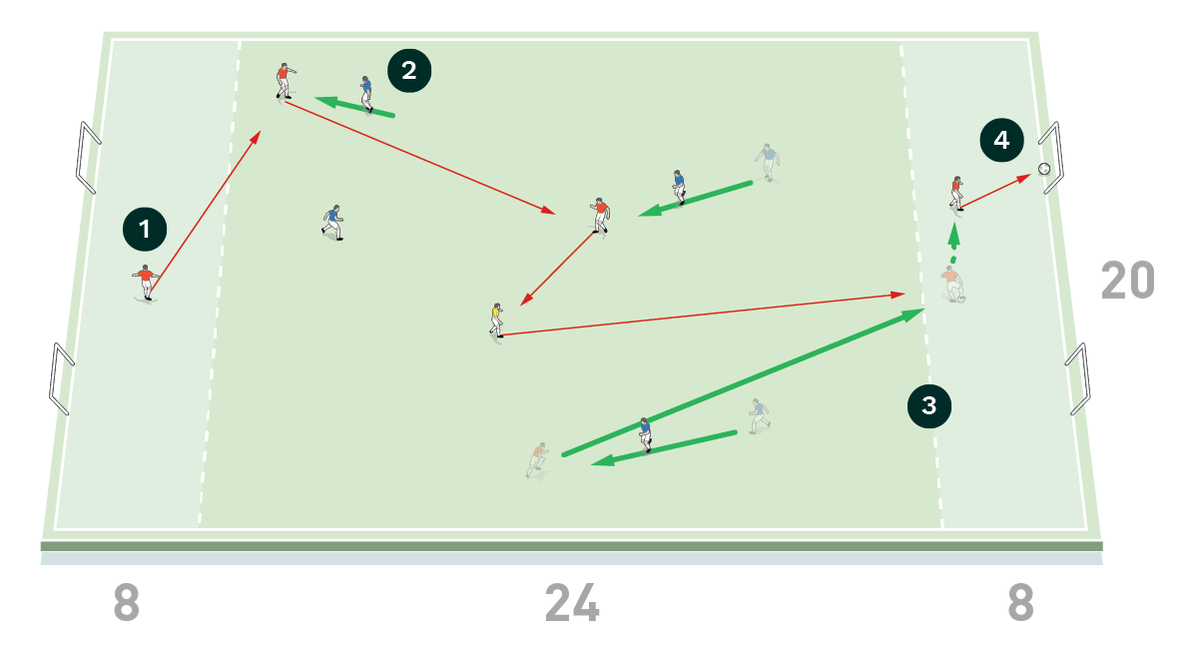
- The reds start with the ball in their end zone and they build an attack on the other end
- The blues press and try to win possession
- The line into the end zone serves as an offside line
- The reds must try to beat the offside trap and score in one of the goals at the end they are attacking
“We use an offside line to encourage players to make runs in behind, using third man actions and off-the-ball runs”
When the ball is dead, play resets and the blues restart play in possession. Building an attack from their end zone, the blues must attack the goals at the other end.
We play four blocks of three minutes.
ATTACKING IN BEHIND 6v6+2
We stretch the pitch to work on the same principles but using bigger angles and distances. We set up a playing area of 60x32 yards with a goal and a keeper at each end and 18-yard end zones. The line into the end zone doubles as an offside line. We’re using 14 outfield players split into a red team of six, a blue team of six and two yellow floaters. The reds start by playing out from the keeper, as shown [3a].
[3a]
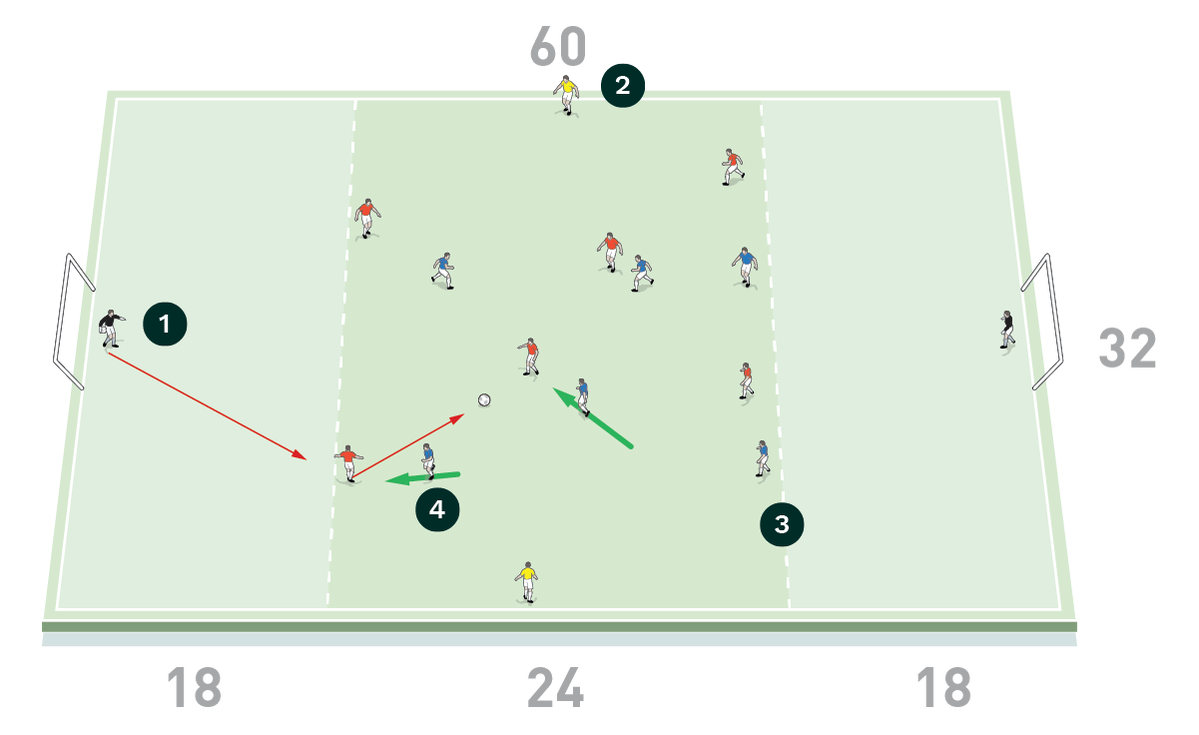
- The reds start with the ball, playing out from the goalkeeper. They try to build an attack on the goal at the other end
- The yellow floaters play for the team in possession. Here they support play from wide, but they can move anywhere providing another player rotates into the wide position
- The line into the end zone serves as an offside line
- The blues press and try to win possession
They look to build an attack and must beat the offside trap to get a shot on goal. If the blues win the ball they counter-attack, as shown [3b], using floaters to give them an 8v6 overload.
[3b]
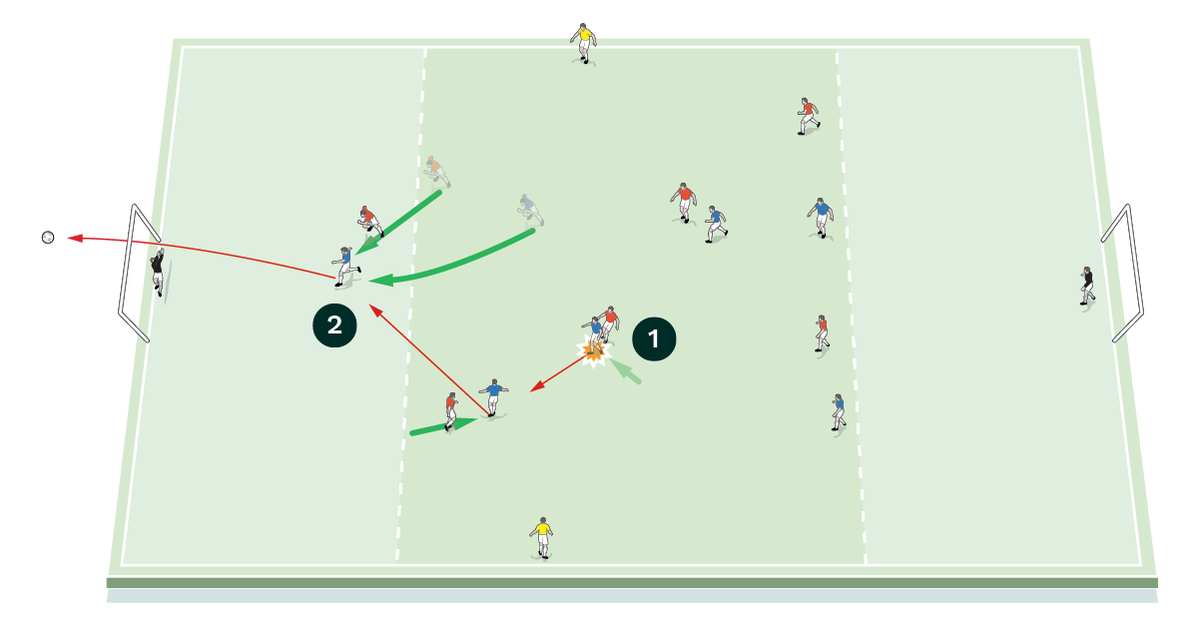
- The blues win possession and must now counter-attack
- The blues make sure they keep onside with a well-timed attacking run
We are always looking to find the free player who is facing forwards, and has a moment of time to make a good pass in behind to a runner. We look for players to make diagonal passes into straight runs from in behind, or straight passes into diagonal runs.
11v11
We set up on a full pitch coned off to a width of 80 yards, with a goal and a goalkeeper at each end.
A back four of mannequins is positioned 30 yards out from the goal line at each end and this serves as the offside line.
We’re using two teams of 11 including keepers and we play a normal 11v11 game, with players encouraged to apply the attacking principles rehearsed in the previous practices, as shown [4].
[4]

- The reds are in possession and players are encouraged to apply the attacking principles rehearsed in the previous practices
- The blues look to apply pressure on the ball and try to prevent forward passes
- The line of mannequins serves as an offside line
- The reds work the ball to find an attacker who makes a well-timed run to stay onside and scores
COACHING POINTS
What are the key things to look out for?
Players who are looking to make the killer pass will need to be constantly assessing where the gaps in the defence could be and where a passing lane could emerge. Before that, we want to maintain positional superiority in possession and be able to find the free man either directly or from the third man’s run.
Defensively, we want to constantly apply pressure on the ball and prevent forward passes. After a regain we will look to find the free player quickly and encourage the first pass to be made in transition so it leads to a killer ball on the second pass. We want the game to flow and maintain a high intensity.
With the emphasis on playing attacking passes in behind, players always need to think two steps ahead and they should be asking themselves the following questions: am I able to receive the ball and make a pass in behind, and if not can I link with someone who can?
This session was used as part of evolving from a positional play style, to something more fluid and combination-play based. We have a lot of technical players who are capable of playing one and two touch, but we wanted to get these players off the ball to offer an out-ball. This is to assist the decision making both on and off the ball, and to help players understand that we need runners to stretch the play and to offer forward passes to create more space between the lines to play into.
What are the typical mistakes players might make and how do I avoid them?
Often players rush the forward pass and there are no runners ready to receive or run onto the ball, so we need to emphasise the timing, angle and type of pass to use.
Often, the pass can be rushed and lack quality, or it is made with poor timing. Usually, we can correct the positional shape and non-verbal communication such as which foot to pass to.
We want to encourage passes in behind at the right moment to create chances, rather than using them at every opportunity.
Related Files
Editor's Picks
Deep runs in the final third
Using the goalkeeper in build-up play
Pressing principles
Intensive boxes drill with goals
Penetrating the final third
Creating and finishing
My philosophy
Pressing initiation
Compact team movement
Coaches' Testimonials

Alan Pardew

Arsène Wenger

Brendan Rodgers

Carlos Carvalhal

José Mourinho

Jürgen Klopp

Pep Guardiola

Roy Hodgson

Sir Alex Ferguson

Steven Gerrard
Coaches' Testimonials

Gerald Kearney, Downtown Las Vegas Soccer Club

Paul Butler, Florida, USA

Rick Shields, Springboro, USA

Tony Green, Pierrefonds Titans, Quebec, Canada
Join the world's leading coaches and managers and discover for yourself one of the best kept secrets in coaching. No other training tool on the planet is written or read by the calibre of names you’ll find in Elite Soccer.
In a recent survey 92% of subscribers said Elite Soccer makes them more confident, 89% said it makes them a more effective coach and 91% said it makes them more inspired.
Get Monthly Inspiration
All the latest techniques and approaches
Since 2010 Elite Soccer has given subscribers exclusive insight into the training ground practices of the world’s best coaches. Published in partnership with the League Managers Association we have unparalleled access to the leading lights in the English leagues, as well as a host of international managers.
Elite Soccer exclusively features sessions written by the coaches themselves. There are no observed sessions and no sessions “in the style of”, just first-hand advice delivered direct to you from the coach.
